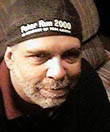|
|
 
|
|
Author
|
Topic: This Is Cinerama
|
Thomas Pitt
Master Film Handler

Posts: 266
From: Leeds, West Yorkshire, UK
Registered: May 2007
|
 posted 09-04-2007 03:27 PM
posted 09-04-2007 03:27 PM




I finally managed to see "This is Cinerama" in Bradford on Saturday. Still running in its original 3-strip format, a print has recently been struck from the original negatives. It also used the original magnetic soundtrack, plus the beginning b/w reel to introduce the main show.
The effect was quite interesting - although the joins between the three projected images were very noticeable at first, you eventually started to ignore it and just watch the picture as a whole.
What I couldn't ignore though was the fact that the color temperature tended to vary dramatically. It wasn't like fading, with wavering red on the middle of the image, it was more like turning the hue control on a TV to its extremes. Most of the time it only affected one of the three projectors; you could really see the difference where the joins were.
Oddly, the 'bad' scenes seemed to fix themselves upon the next camera cut, as if the discolored film was spliced onto a good film at the cut. The projectionist told me that the original negatives had faded in places - but surely that would be a gradual fade, not suddenly cutting to a piece of discolored film!
Has anyone else seen This Is Cinerama, or knows why this effect would occur?
| IP: Logged
|
|
|
|
Leo Enticknap
Film God

Posts: 7474
From: Loma Linda, CA
Registered: Jul 2000
|
 posted 09-04-2007 03:45 PM
posted 09-04-2007 03:45 PM





I've seen it a couple of times. Is this a new print, as in, made in the last couple of years or so? The one I saw (last time was around Christmas '04) looked pretty old and worn to me. It's great news if they have managed to have a new print struck - that can't have been cheap.
quote:
he projectionist told me that the original negatives had faded in places - but surely that would be a gradual fade, not suddenly cutting to a piece of discolored film!
That's actually quite possible. In the very early days of chromogenic tripack, the manufacturing process was very unreliable and inconsistent. It's quite possible that one batch of negative stock could have survived very well, while the next one after it faded very quickly. If different stock types, batches, or even makes were mixed during the production, then cuts between faded and less faded shots, depending on how the negatives were assembled, are pretty common. It's exactly the same principle whereby you can pull out two reels of nitrate from the very same release print even, and find that one of them looks pristine like the day it came out of the lab's drying machine, but the other has already started to bubble and go sticky.
| IP: Logged
|
|
|
|
Mark Ogden
Jedi Master Film Handler
Posts: 943
From: Little Falls, N.J.
Registered: Jun 99
|
 posted 09-04-2007 10:18 PM
posted 09-04-2007 10:18 PM




quote: Louis Bornwasser
These were not production guys, but cutting edge projection guys
Thatís not really true. This Is Cinerama was largely produced and directed by Merian Cooper, the director of King Kong and a man certainly well versed in motion picture production technology.
As to what you have reported seeing, are you sure that is was a newly struck print? For the longest time, the Bradford Museumís copy of the film was one of the original 1952 prints that had been cobbled together and loaned by John Harvey. It would seem to make sense that portions of the picture could be faded, even on a splice-by-splice basis. All the recent prints off the original neg were (as far as I know) struck by Crest Labs in 2002. I remember John Sittig telling me that, faded negatives aside, they did a meticulous job retiming the film, even going so far as to build a Cinerama screening-room just to QC the restoration. The last time I saw the picture (in L.A. in 2004), the new print looked great, but at one screening there was an obvious color temperature shift in the center panel as a new bulb had been installed in the B projector prior to the show and it had not settled in yet. Could something like that have happened, a lamp or flickering bulb issue as opposed to a print problem?
| IP: Logged
|
|
|
|
Leo Enticknap
Film God

Posts: 7474
From: Loma Linda, CA
Registered: Jul 2000
|
 posted 09-05-2007 03:12 AM
posted 09-05-2007 03:12 AM





quote: Mark Ogden
For the longest time, the Bradford Museumís copy of the film was one of the original 1952 prints that had been cobbled together and loaned by John Harvey. It would seem to make sense that portions of the picture could be faded, even on a splice-by-splice basis.
Based on what I remember seeing, that would make sense. Taking Mark's point about the original release prints being IB, that leaves an interesting question: were the inconsistencies Thomas noticed the result of the cobbled together print or mismatches in the colour balance of the original negative stock (be they from original manufacture, the result of fading)? If the cobbled-together print is from IB elements, then Eastmancolor fading of the actual print clearly isn't the culprit.
quote: Mark Ogden
The last time I saw the picture (in L.A. in 2004), the new print looked great, but at one screening there was an obvious color temperature shift in the center panel as a new bulb had been installed in the B projector prior to the show and it had not settled in yet. Could something like that have happened, a lamp or flickering bulb issue as opposed to a print problem?
The guys at Bradford are some of the best in the business, and I've never seen a show there that hasn't been presented flawlessly: so I'm sure that they would have tried to avoid a lamp mismatch. That having been said, the museum has been going through some restructuring and financial issues recently, so it may be that that extra £300 to replace a lamp in one of the side projectors might have got deferred on the grounds that it only gets used once or twice a month.
From my memory of Bradford's TIC print, the worst mismatches are in the Edinburgh Tattoo sequence, in which the left panel goes seriously pink for three or four minutes, and then again during the girls waterski-ing, when the centre panel goes notably off. But other than that I didn't think the colour was too bad, but the print was getting notably scratched and worn throughout.
| IP: Logged
|
|
|
|
|
|
Bryan M. Montgomery
Film Handler

Posts: 47
From: Chillicothe, Ohio
Registered: Jul 2007
|
 posted 09-06-2007 01:33 AM
posted 09-06-2007 01:33 AM





I had the pleasure of talking for quite some time to the Cinerama guru himself, John Harvey while opening a 20 -plex in Beavercreek, Oh (a subburb of Dayton.) He explained that the process of piecing these prints together isnt perfect, you'll get one reel faded to red,while others look just great. I'm wondering, since you mentioned very noticable edge lines on screen, whether or not the "jiggaloos" I believe they were called, were installed as they should be, (if its the original three strip process that is.) These oddly named devices were, I believe either specially cut aperture plates or a metal plate placed just beyond the gate and to one side that had a saw tooth pattern cut into the side where the images met, it helped blend the two images better from what I understand. John was a very interesting guy to talk to.
| IP: Logged
|
|
|
|
|
|
|
|
|
|
|
|
|
|
All times are Central (GMT -6:00)
|
|
Powered by Infopop Corporation
UBB.classicTM
6.3.1.2
The Film-Tech Forums are designed for various members related to the cinema industry to express their opinions, viewpoints and testimonials on various products, services and events based upon speculation, personal knowledge and factual information through use, therefore all views represented here allow no liability upon the publishers of this web site and the owners of said views assume no liability for any ill will resulting from these postings. The posts made here are for educational as well as entertainment purposes and as such anyone viewing this portion of the website must accept these views as statements of the author of that opinion
and agrees to release the authors from any and all liability.
|

 Home
Home
 Products
Products
 Store
Store
 Forum
Forum
 Warehouse
Warehouse
 Contact Us
Contact Us




 Printer-friendly view of this topic
Printer-friendly view of this topic












![[Big Grin]](biggrin.gif)





